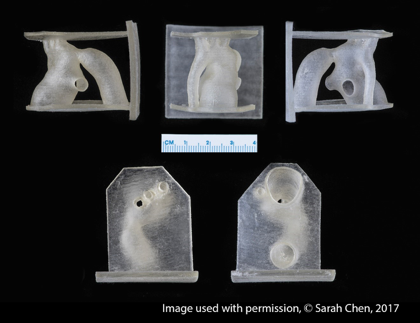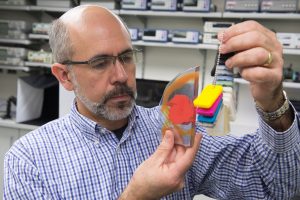Through 3-D printing, a model is built with layers of molten or light-cured plastic resin. Large companies, like Ford and General Electric, use 3-D printing to make intricate parts that cannot be made through traditional manufacturing. But 3-D printing can also be used in healthcare to produce accurate, scaled models of human organs that are rigid or flexible, colorized or clear. What’s more, with virtual reality, users can interact with 3-D data, rotating and viewing cross-sections of some of the anatomical models to quickly convert 3-D images to a form that’s ready to print.
Over the last few years, 3-D printing and virtual reality visualization have become popular topics in the medical field, particularly for preplanning surgeries.
“This is a very hot topic in radiology and surgery,” says Jeffrey Siewerdsen, professor of biomedical engineering and co-director of the Carnegie Center for Surgical Innovation, which houses the new 3-D print facility. “And it is great to see the technology put to meaningful use for clinicians.”
But it wasn’t until February 2016, with the purchase of the facility’s first printer, that the Johns Hopkins Hospital could produce complex 3-D prints in-house. The impetus came from the clinic, specifically, the Department of Neurosurgery. With support from a patient’s generous donation, neurosurgeons and biomedical engineers set out to create new capabilities for 3-D printing at Johns Hopkins. The patient’s donation was matched with support from the Johns Hopkins Institute for Clinical and Translational Research and the printer’s manufacturer, Stratasys.
The genesis of the new 3-D print facility at Johns Hopkins illustrates just how transformational 3-D printing can be, putting patient-specific organ models into the hands of surgeons, and giving patients a better understanding of their own medical condition.
“Patients gain a better understanding of their condition when they hold a model of their heart or brain tumor,” says Siewerdsen. “It gives an entirely different level of understanding than just looking at an MRI scan.”
Garcia says the facility is now assembling the assets it needs to serve surgeons and clinicians at Johns Hopkins Hospital. He plans to work with physicians and researchers across departments, including Surgery, Otolaryngology, and Radiation Oncology in order to bring 3-D printing into the mainstream of modern medicine through patient education, surgical planning, and surgical simulation.
– Andrew Zaleski


